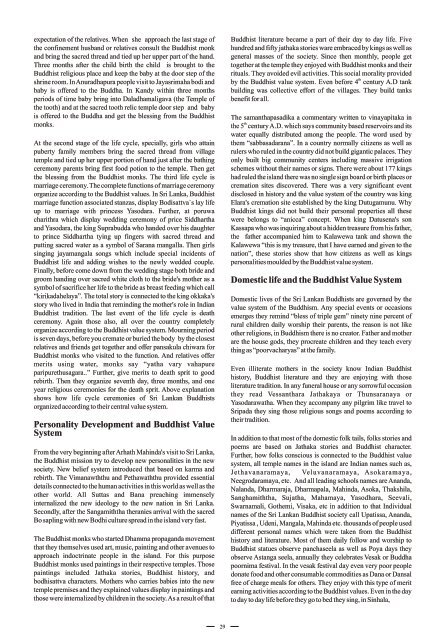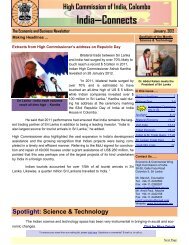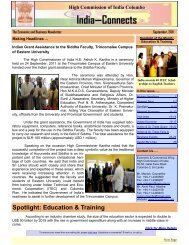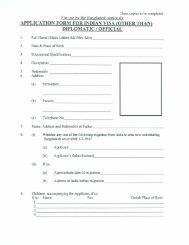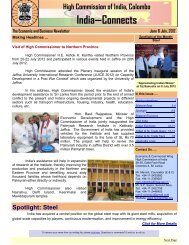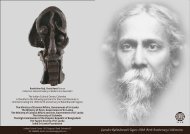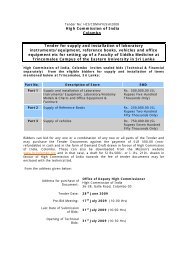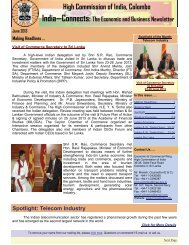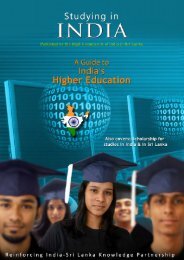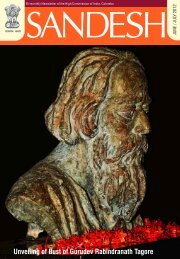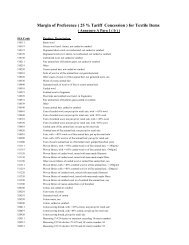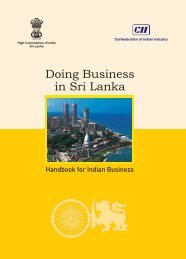Papers presented at the International Buddhist Conference, March ...
Papers presented at the International Buddhist Conference, March ...
Papers presented at the International Buddhist Conference, March ...
Create successful ePaper yourself
Turn your PDF publications into a flip-book with our unique Google optimized e-Paper software.
expect<strong>at</strong>ion of <strong>the</strong> rel<strong>at</strong>ives. When she approach <strong>the</strong> last stage of<br />
<strong>the</strong> confinement husband or rel<strong>at</strong>ives consult <strong>the</strong> <strong>Buddhist</strong> monk<br />
and bring <strong>the</strong> sacred thread and tied up her upper part of <strong>the</strong> hand.<br />
Three months after <strong>the</strong> child birth <strong>the</strong> child is brought to <strong>the</strong><br />
<strong>Buddhist</strong> religious place and keep <strong>the</strong> baby <strong>at</strong> <strong>the</strong> door step of <strong>the</strong><br />
shrine room. In Anuradhapura people visit to Jayasrimaha bodi and<br />
baby is offered to <strong>the</strong> Buddha. In Kandy within three months<br />
periods of time baby bring into Daladhamaligava (<strong>the</strong> Temple of<br />
<strong>the</strong> tooth) and <strong>at</strong> <strong>the</strong> sacred tooth relic temple door step and baby<br />
is offered to <strong>the</strong> Buddha and get <strong>the</strong> blessing from <strong>the</strong> <strong>Buddhist</strong><br />
monks.<br />
At <strong>the</strong> second stage of <strong>the</strong> life cycle, specially, girls who <strong>at</strong>tain<br />
puberty family members bring <strong>the</strong> sacred thread from village<br />
temple and tied up her upper portion of hand just after <strong>the</strong> b<strong>at</strong>hing<br />
ceremony parents bring first food potion to <strong>the</strong> temple. Then get<br />
<strong>the</strong> blessing from <strong>the</strong> <strong>Buddhist</strong> monks. The third life cycle is<br />
marriage ceremony. The complete functions of marriage ceremony<br />
organize according to <strong>the</strong> <strong>Buddhist</strong> values. In Sri Lanka, <strong>Buddhist</strong><br />
marriage function associ<strong>at</strong>ed stanzas, display Bodis<strong>at</strong>tva`s lay life<br />
up to marriage with princess Yasodara. Fur<strong>the</strong>r, <strong>at</strong> poruwa<br />
charithra which display wedding ceremony of price Siddhartha<br />
and Yasodara, <strong>the</strong> king Suprabudda who handed over his daughter<br />
to prince Siddhartha tying up fingers with sacred thread and<br />
putting sacred w<strong>at</strong>er as a symbol of Sarana mangalla. Then girls<br />
singing jayamangala songs which include special incidents of<br />
<strong>Buddhist</strong> life and adding wishes to <strong>the</strong> newly wedded couple.<br />
Finally, before come down from <strong>the</strong> wedding stage both bride and<br />
groom handing over sacred white cloth to <strong>the</strong> bride's mo<strong>the</strong>r as a<br />
symbol of sacrifice her life to <strong>the</strong> bride as breast feeding which call<br />
“kirikadahelaya”. The total story is connected to <strong>the</strong> king okkaka's<br />
story who lived in India th<strong>at</strong> reminding <strong>the</strong> mo<strong>the</strong>r's role in Indian<br />
<strong>Buddhist</strong> tradition. The last event of <strong>the</strong> life cycle is de<strong>at</strong>h<br />
ceremony. Again those also, all over <strong>the</strong> country completely<br />
organize according to <strong>the</strong> <strong>Buddhist</strong> value system. Mourning period<br />
is seven days, before you crem<strong>at</strong>e or buried <strong>the</strong> body by <strong>the</strong> closest<br />
rel<strong>at</strong>ives and friends get toge<strong>the</strong>r and offer pansakula chiwara for<br />
<strong>Buddhist</strong> monks who visited to <strong>the</strong> function. And rel<strong>at</strong>ives offer<br />
merits using w<strong>at</strong>er, monks say “y<strong>at</strong>ha vary vahapure<br />
paripurethusagara..” Fur<strong>the</strong>r, give merits to de<strong>at</strong>h sprit to good<br />
rebirth. Then <strong>the</strong>y organize seventh day, three months, and one<br />
year religious ceremonies for <strong>the</strong> de<strong>at</strong>h sprit. Above explan<strong>at</strong>ion<br />
shows how life cycle ceremonies of Sri Lankan <strong>Buddhist</strong>s<br />
organized according to <strong>the</strong>ir central value system.<br />
Personality Development and <strong>Buddhist</strong> Value<br />
System<br />
From <strong>the</strong> very beginning after Arh<strong>at</strong>h Mahinda's visit to Sri Lanka,<br />
<strong>the</strong> <strong>Buddhist</strong> mission try to develop new personalities in <strong>the</strong> new<br />
society. New belief system introduced th<strong>at</strong> based on karma and<br />
rebirth. The Vimanawththu and Pethaw<strong>at</strong>hthu provided essential<br />
details connected to <strong>the</strong> human activities in this world as well as <strong>the</strong><br />
o<strong>the</strong>r world. All Suttas and Bana preaching immensely<br />
internalized <strong>the</strong> new ideology to <strong>the</strong> new n<strong>at</strong>ion in Sri Lanka.<br />
Secondly, after <strong>the</strong> Sangamiththa <strong>the</strong>ranies arrival with <strong>the</strong> sacred<br />
Bo sapling with new Bodhi culture spread in <strong>the</strong> island very fast.<br />
The <strong>Buddhist</strong> monks who started Dhamma propaganda movement<br />
th<strong>at</strong> <strong>the</strong>y <strong>the</strong>mselves used art, music, painting and o<strong>the</strong>r avenues to<br />
approach indoctrin<strong>at</strong>e people in <strong>the</strong> island. For this purpose<br />
<strong>Buddhist</strong> monks used paintings in <strong>the</strong>ir respective temples. Those<br />
paintings included J<strong>at</strong>haka stories, <strong>Buddhist</strong> history, and<br />
bodhis<strong>at</strong>tva characters. Mo<strong>the</strong>rs who carries babies into <strong>the</strong> new<br />
temple premises and <strong>the</strong>y explained values display in paintings and<br />
those were internalized by children in <strong>the</strong> society. As a result of th<strong>at</strong><br />
<strong>Buddhist</strong> liter<strong>at</strong>ure became a part of <strong>the</strong>ir day to day life. Five<br />
hundred and fifty j<strong>at</strong>haka stories ware embraced by kings as well as<br />
general masses of <strong>the</strong> society. Since <strong>the</strong>n monthly, people get<br />
toge<strong>the</strong>r <strong>at</strong> <strong>the</strong> temple <strong>the</strong>y enjoyed with <strong>Buddhist</strong> monks and <strong>the</strong>ir<br />
rituals. They avoided evil activities. This social morality provided<br />
th<br />
by <strong>the</strong> <strong>Buddhist</strong> value system. Even before 4 century A.D tank<br />
building was collective effort of <strong>the</strong> villages. They build tanks<br />
benefit for all.<br />
The samanthapasadika a commentary written to vinayapitaka in<br />
th<br />
<strong>the</strong> 5 century A.D. which says community based reservoirs and its<br />
w<strong>at</strong>er equally distributed among <strong>the</strong> people. The word used by<br />
<strong>the</strong>m “sabbasadarana”. In a country normally citizens as well as<br />
rulers who ruled in <strong>the</strong> country did not build gigantic palaces. They<br />
only built big community centers including massive irrig<strong>at</strong>ion<br />
schemes without <strong>the</strong>ir names or signs. There were about 177 kings<br />
had ruled <strong>the</strong> island <strong>the</strong>re was no single sign board or birth places or<br />
crem<strong>at</strong>ion sites discovered. There was a very significant event<br />
disclosed in history and <strong>the</strong> value system of <strong>the</strong> country was king<br />
Elara's crem<strong>at</strong>ion site established by <strong>the</strong> king Dutugamunu. Why<br />
<strong>Buddhist</strong> kings did not build <strong>the</strong>ir personal properties all <strong>the</strong>se<br />
were belongs to “anicca” concept. When king D<strong>at</strong>usena's son<br />
Kassapa who was inquiring about a hidden treasure from his f<strong>at</strong>her,<br />
<strong>the</strong> f<strong>at</strong>her accompanied him to Kalawewa tank and shown <strong>the</strong><br />
Kalawewa “this is my treasure, th<strong>at</strong> I have earned and given to <strong>the</strong><br />
n<strong>at</strong>ion”, <strong>the</strong>se stories show th<strong>at</strong> how citizens as well as kings<br />
personalities moulded by <strong>the</strong> <strong>Buddhist</strong> value system.<br />
Domestic life and <strong>the</strong> <strong>Buddhist</strong> Value System<br />
Domestic lives of <strong>the</strong> Sri Lankan <strong>Buddhist</strong>s are governed by <strong>the</strong><br />
value system of <strong>the</strong> Buddhism. Any special events or occasions<br />
emerges <strong>the</strong>y remind “bless of triple gem” ninety nine percent of<br />
rural children daily worship <strong>the</strong>ir parents, <strong>the</strong> reason is not like<br />
o<strong>the</strong>r religions, in Buddhism <strong>the</strong>re is no cre<strong>at</strong>or. F<strong>at</strong>her and mo<strong>the</strong>r<br />
are <strong>the</strong> house gods, <strong>the</strong>y procre<strong>at</strong>e children and <strong>the</strong>y teach every<br />
thing as “poorvacharyas” <strong>at</strong> <strong>the</strong> family.<br />
Even illiter<strong>at</strong>e mo<strong>the</strong>rs in <strong>the</strong> society know Indian <strong>Buddhist</strong><br />
history, <strong>Buddhist</strong> liter<strong>at</strong>ure and <strong>the</strong>y are enjoying with those<br />
liter<strong>at</strong>ure tradition. In any funeral house or any sorrowful occasion<br />
<strong>the</strong>y read Vessanthara J<strong>at</strong>hakaya or Thunsaranaya or<br />
Yasodaraw<strong>at</strong>ha. When <strong>the</strong>y accompany any pilgrim like travel to<br />
Sripada <strong>the</strong>y sing those religious songs and poems according to<br />
<strong>the</strong>ir tradition.<br />
In addition to th<strong>at</strong> most of <strong>the</strong> domestic folk tails, folks stories and<br />
poems are based on J<strong>at</strong>haka stories and <strong>Buddhist</strong> character.<br />
Fur<strong>the</strong>r, how folks conscious is connected to <strong>the</strong> <strong>Buddhist</strong> value<br />
system, all temple names in <strong>the</strong> island are Indian names such as,<br />
Jethavanaramaya, Veluvanaramaya, Asokaramaya,<br />
Neegrodaramaya, etc. And all leading schools names are Ananda,<br />
Nalanda, Dharmaraja, Dharmapala, Mahinda, Asoka, Thakshila,<br />
Sanghamiththa, Suj<strong>at</strong>ha, Mahamaya, Yasodhara, Seevali,<br />
Swarnamali, Go<strong>the</strong>mi, Visaka, etc in addition to th<strong>at</strong> Individual<br />
names of <strong>the</strong> Sri Lankan <strong>Buddhist</strong> society call Up<strong>at</strong>issa, Ananda,<br />
Piy<strong>at</strong>issa , Udeni, Mangala, Mahinda etc. thousands of people used<br />
different personal names which were taken from <strong>the</strong> <strong>Buddhist</strong><br />
history and liter<strong>at</strong>ure. Most of <strong>the</strong>m daily follow and worship to<br />
<strong>Buddhist</strong> st<strong>at</strong>ues observe panchaseela as well as Poya days <strong>the</strong>y<br />
observe Astanga seela, annually <strong>the</strong>y celebr<strong>at</strong>es Vesak or Buddha<br />
poornima festival. In <strong>the</strong> vesak festival day even very poor people<br />
don<strong>at</strong>e food and o<strong>the</strong>r consumable commodities as Dana or Dansal<br />
free of charge meals for o<strong>the</strong>rs. They enjoy with this type of merit<br />
earning activities according to <strong>the</strong> <strong>Buddhist</strong> values. Even in <strong>the</strong> day<br />
to day to day life before <strong>the</strong>y go to bed <strong>the</strong>y sing, in Sinhala,<br />
29


